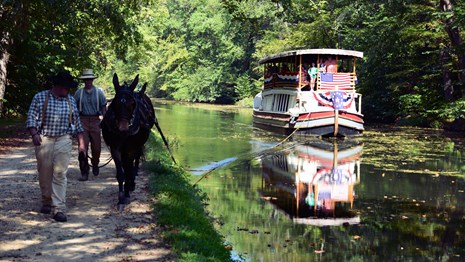
The C&O Canal National Historical Park boasts some of the most breathtaking scenery in the area. Not only is our Park magnificent to look at, but it is home to many natural and man-made wonders. The architects and builders who built the canal had to overcome rocky land, mountains, and changes in elevation, and through these difficulties, many architectural wonders were born. Below, we take a closer look at 10 of them in honor of the C&O Canal Trust’s 10th anniversary.
1. Canal Locks
Few structures speak to the architectural achievements during the creation of the canal more than the canal locks. Locks based on designs by Leonardo da Vinci helped the boats overcome changes in elevation as they proceeded along the canal. These hand-operated locks worked by enclosing a boat between two gates, and either filling or emptying the water in the lock to meet water levels on the other side, thereby elevating or lowering the boats.
Today, these locks stand as a gateway to another time and are sure to be one of the many highlights of your trip to the C&O Canal. You can see a list of all the locks along the canal and plan your next visit at https://www.canaltrust.org/pyvactivities/locks/, and you can actually ride a canal boat through a working lock in Great Falls. (https://www.nps.gov/choh/planyourvisit/interpretiverangerprograms.htm)
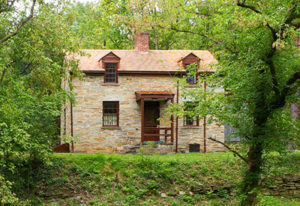
Lockhouse 10 – photo by C&O Canal Trust
2. Lockhouses
A favorite of Park visitors, the historic lockhouses were built to house the lock keepers who operated the locks to allow boats safe passage along the canal. Most lockhouses, which often house large families, were made of stone and were comprised of four small rooms. You can experience life as a canal lock keeper by spending a night in one of our rehabbed lockhouses that are part of the Canal Quarters program. Not only are these lockhouses full of history, but they afford you the opportunity to immerse yourself in the nature that surrounds your home away from home.
3. Aqueducts
The canal’s 14 aqueducts are among the most ingenious and beautiful of the canal’s architectural structures. These aqueducts, made of hand-laid stone, were built to allow the canal and towpath to pass over streams and creeks flowing into the Potomac River. In Williamsport the Conococheague Aqueduct is currently being rehabilitated to repair damage and to restore its functionality. At the conclusion of this project, guests will be able to take a boat ride over the aqueduct! This page lists all 14 aqueducts.
4. Culverts
Similar in design to the aqueducts, but much smaller are the 150 stone culverts that carry small streams’ seasonal rain runoff under the towpath and canal. Because of the large number of culverts that were needed, their construction was a huge undertaking. Often overlooked, they are critical to the maintenance of the towpath. Keep an eye out for culverts whenever you see a creek running near the towpath.
5. Towpath
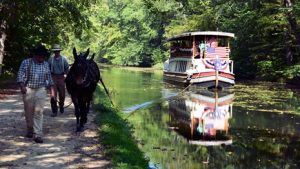
C&O Canal Towpath – photo by NPS
The towpath, which stretches 184.5 miles from Georgetown to Cumberland, got its name because boats proceeding along the canal were towed by mules walking on the path. Today, the towpath is the main thoroughfare for hikers, bikers, joggers, and walkers who use the Park for recreation and exercise. Open year-round, except during high water or severe winter weather, the towpath offers beautiful views and a peaceful environment to enjoy the natural surroundings.
6.Canal Prism
The canal prism is the area that was built to hold the water of the canal. At the time of the canal’s construction, the C&O’s prism was the largest of all the canals in the United States, measuring 184.5 miles long and 60 feet wide. Today, most parts of the canal are not watered, and you can see the remains of the canal prism. Reflecting on this massive prism dug out by so many workers allows you to appreciate the incredible amount of work that went into the creation of this historic canal.
7. Historic Great Falls Tavern
The Great Falls area is one of the most popular areas of the Park and rightfully so: it is here that you can see where the Potomac River drops over the fall line from the Piedmont geologic province to the Atlantic Coastal Plain, forming beautiful rapids and waterfalls much loved by expert kayakers. This area has some of the most majestic scenery the Park has to offer, and is the site of the Historic Great Falls Tavern. Built as a small lockhouse in 1828, the lock keeper soon added two additions around 1830 to capitalize on its proximity to Great Falls. The structure became a popular tavern named the Crommelin House after the Dutch family that secured the loans for the canal company. The destination now serves as one of the canal’s Visitor Centers.
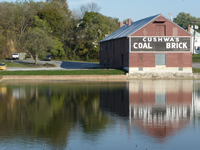
Cushwa Basin Warehouse – photo by C&O Canal Trust
8. Cushwa Basin Warehouse & Basin
Among the many historic buildings in the Park, the Cushwa Basin Warehouse is one of the oldest, predating even the canal itself. This warehouse served as one of the major points along the canal where boats could load/unload their cargo. The Cushwa Basin is also one of the few areas along the canal where a boat can actually turn around. There is no shortage of things to do while visiting the basin in Williamsport — here is a list of some of the Great Things to Do When You Visit Cushwa Basin.
9. Paw Paw Tunnel
The construction of the Paw Paw Tunnel was one of the most difficult construction challenges tackled during the canal’s construction, taking 12 years and nearly bankrupting the entire C&O Canal Company. Spanning 3,118 feet, the Paw Paw Tunnel burrows through the mountains that blocked the western progress of the canal. During your visit, you can wander through this fantastic engineering achievement that consists of nearly six million bricks – but remember to bring a flashlight!
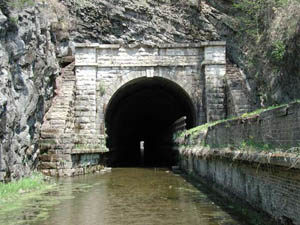
Paw Paw Tunnel – photo by NPS
10. Dams 4 and 5
Originally built of timber, seven dams were created with the dual purposes of diverting water into the canal from the Potomac River and as sources of power. Perhaps the most well-known of the seven original dams are Dam 4 and Dam 5, which are still in use today. Few of the architectural wonders of the C&O Canal National Historical Park provide such a revealing glimpse into the tenacity of the workers as the raw power of the canal’s dams.
Written by Collin Campion





